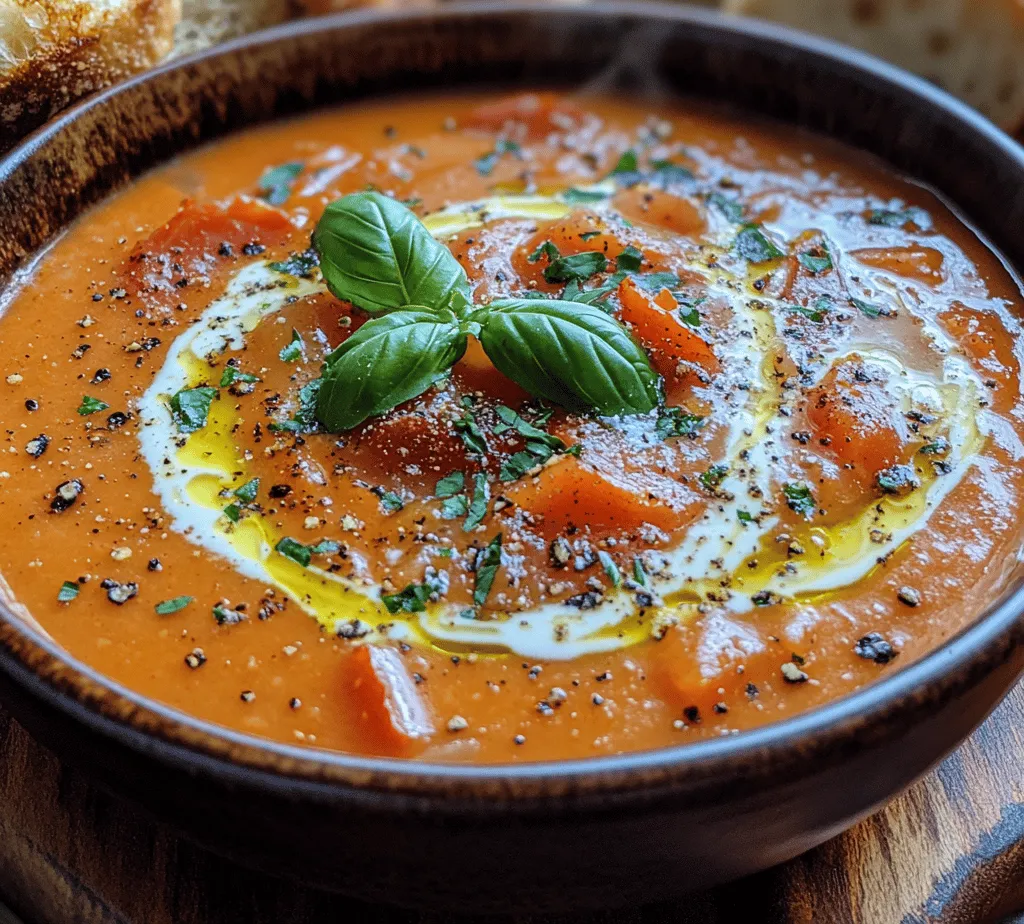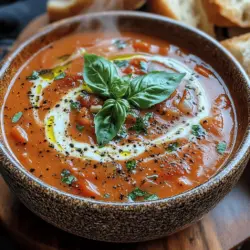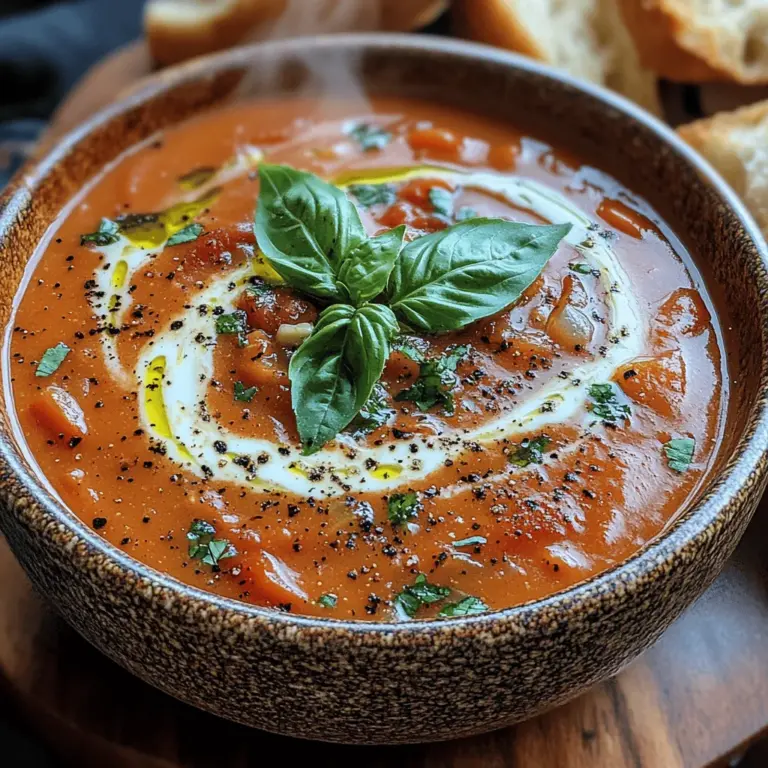Introduction
In the realm of comfort food, few dishes hold a candle to the rich, robust flavor of Fire-Roasted Tomato Basil Soup. This delightful concoction marries the natural sweetness of tomatoes with the aromatic essence of fresh basil, delivering a warm hug in a bowl. Its appeal lies not only in its sumptuous taste but also in its simplicity—transforming humble ingredients into a gourmet experience. Whether served as a starter at an elegant dinner party or enjoyed as a cozy meal on a chilly evening, this soup is incredibly versatile, making it a staple in many kitchens.
The secret to this soup’s incredible flavor primarily hinges on fresh, high-quality ingredients and a meticulous roasting technique. Roasting vegetables elevates their natural sugars, intensifying their flavors and creating a depth that can’t be achieved through boiling or steaming alone. Imagine thick, luscious tomato soup with a touch of smoky complexity, all thanks to the art of roasting.
Moreover, this Fire-Roasted Tomato Basil Soup is adaptable to various occasions. Serve it with crusty bread for a casual lunch, pair it with a gourmet grilled cheese sandwich for a nostalgic dinner, or elevate it with a drizzle of cream and a sprinkle of fresh herbs for a more refined presentation. No matter how you choose to enjoy it, this soup is sure to impress your palate and warm your soul.
Understanding the Ingredients
The soul of any recipe lies in its ingredients, and Fire-Roasted Tomato Basil Soup is no exception. Let’s delve into the key components that make this dish not only delicious but also nutritious.
Fresh Tomatoes: Nutritional Benefits and Flavor Profiles
At the heart of this soup are fresh tomatoes, which provide both the base and the primary flavor. Tomatoes are rich in vitamins C and K, potassium, and folate. They are also packed with antioxidants, including lycopene, which is linked to numerous health benefits, including a reduced risk of chronic diseases. The flavor profile of fresh tomatoes varies by type; for this soup, using ripe, in-season tomatoes will yield the best results. Their natural sweetness, combined with their acidity, creates a balanced flavor that is both refreshing and savory.
Red Bell Peppers: Sweetness and Color Enhancement
Adding red bell peppers into the mix not only enhances the soup’s vibrant color but also contributes a subtle sweetness that complements the tomatoes. Bell peppers are an excellent source of vitamins A and C, and their crunchy texture when raw transforms into a juicy, tender delight when roasted. This sweetness helps to balance the acidity of the tomatoes, ensuring a well-rounded taste.
Onions and Garlic: Aromatic Base and Flavor Depth
No great soup is complete without an aromatic base, and onions and garlic play a pivotal role in creating a depth of flavor. Onions, when sautéed, caramelize to bring out their natural sweetness, while garlic adds a punch of pungent earthiness. Together, they form a flavor foundation that elevates the entire dish, making it aromatic and inviting.
Olive Oil: Health Benefits and Flavor
Using high-quality extra virgin olive oil in this recipe not only enhances the flavor but also contributes numerous health benefits. Olive oil is rich in healthy monounsaturated fats and antioxidants, making it a heart-healthy choice. It helps in the roasting process by facilitating even cooking and aiding in the caramelization of the vegetables, further enhancing their sweetness and flavor.
Fresh Basil: Aromatic Herb and Its Impact on Taste
Basil is the star herb in this recipe, infusing the soup with its aromatic, slightly sweet, and peppery flavor. Fresh basil is a powerhouse of nutrients, containing vitamins A, K, and C, along with essential oils that provide anti-inflammatory benefits. The addition of fresh basil at the end of cooking ensures that its flavor remains bright and vibrant, contributing to the soup’s overall freshness.
Optional Ingredients: Heavy Cream and Sugar
While the core ingredients create a fantastic foundation, certain optional ingredients can elevate the soup further. Heavy cream can be added to create a luxuriously smooth texture, adding richness that complements the acidity of the tomatoes beautifully. A touch of sugar can also be beneficial; it helps to balance the acidity of the tomatoes, particularly if they are on the tart side. Adding these optional ingredients allows for customization based on personal preferences, making the soup uniquely yours.
The Art of Roasting
Roasting is a critical step in preparing Fire-Roasted Tomato Basil Soup, and understanding the process can significantly enhance the dish’s flavor profile.
Explanation of the Roasting Process
Roasting involves cooking food in an oven at high temperatures, allowing it to develop a crispy exterior while retaining moisture inside. This technique is particularly effective for vegetables, as it caramelizes their natural sugars, intensifying their flavors and creating a rich, complex taste that is essential for this soup.
Benefits of Roasting Vegetables for Soup
One of the main benefits of roasting vegetables for soup is the enhancement of sweetness and depth of flavor. The high heat causes the natural sugars in tomatoes, bell peppers, and onions to caramelize, resulting in a rich, sweet, and slightly smoky flavor that boiling simply cannot replicate. This roasting process also brings out the umami flavors in the vegetables, adding layers of taste that contribute to a gourmet experience.
The Caramelization Effect and Its Impact on Taste
Caramelization occurs when sugars break down under heat, resulting in a characteristic brown color and rich flavor. For this soup, achieving a good caramelization on the tomatoes and bell peppers is crucial. It transforms their taste from merely sweet to deeply flavored and complex, making each spoonful a rewarding experience for the palate.
Comparing Grilling Versus Oven Broiling for Roasting
When it comes to roasting, you have options. Grilling and oven broiling are both excellent methods for achieving that desired char and depth of flavor. Grilling imparts a smoky flavor that can enhance the overall taste, while broiling in the oven allows for even cooking and control over the caramelization process. Depending on your kitchen setup and personal preference, either method can be used effectively to roast the vegetables for this soup.
Step-by-Step Instructions
Now that we’ve covered the ingredients and the importance of roasting, it’s time to dive into the step-by-step instructions for making Fire-Roasted Tomato Basil Soup. Each step is designed to build on the flavors we’ve discussed, ensuring a delicious end result.
Roasting the Vegetables
1. Preheat Your Oven: Start by preheating your oven to 450°F (232°C). A high temperature is critical for achieving that perfect roast.
2. Prepare the Vegetables: Wash your fresh tomatoes and red bell peppers thoroughly. Cut the tomatoes in half and remove the core. For the bell peppers, slice them in half, remove the seeds, and cut them into quarters.
3. Slice Onions and Garlic: Peel and quarter the onions, and separate the layers for even roasting. For the garlic, you can leave the cloves in their skins for a more mellow flavor during roasting.
4. Toss with Olive Oil: In a large bowl, combine the prepared tomatoes, bell peppers, onions, and garlic. Drizzle generously with extra virgin olive oil, and season with salt and freshly cracked black pepper. Toss everything until well coated.
5. Arrange on Baking Sheet: Spread the vegetables out in a single layer on a baking sheet lined with parchment paper. Make sure they’re not overcrowded, as this will allow them to roast evenly.
6. Roast in the Oven: Place the baking sheet in the preheated oven and roast for about 25-30 minutes, or until the vegetables are tender and have developed a nice char. Keep an eye on them to prevent burning, especially the garlic, which can become bitter if overcooked.
Tips for Achieving the Perfect Char
– Even Spacing: Ensure that vegetables are spaced out on the baking sheet to enable even cooking.
– Rotate the Sheet: Halfway through roasting, rotate the baking sheet to ensure all sides of the vegetables receive equal heat.
– Watch the Garlic: If the garlic cloves start to brown too quickly, you can remove them earlier than the other vegetables.
Importance of Even Cooking
Even cooking is crucial for achieving a uniform flavor in your soup. If some vegetables are overcooked while others are undercooked, it can lead to an unbalanced taste and texture. This is why preparing your vegetables in similar sizes and ensuring they have enough space to roast evenly is essential.
Cooling and Peeling
Once the vegetables are roasted to perfection, remove them from the oven and let them cool slightly.
– Peel the Garlic: The skins of the garlic cloves will be soft and easy to remove after roasting. Simply squeeze them out of their skins, and they will pop out effortlessly.
Blending the Soup
1. Transfer to Blender: In batches, transfer the roasted vegetables to a high-speed blender.
2. Add Broth: Pour in vegetable or chicken broth to help with blending. The amount will depend on your desired consistency; start with about 2 cups and adjust as needed.
3. Blend Until Smooth: Blend the mixture until it reaches your desired smoothness. For a chunkier texture, blend less; for a silkier soup, blend more.
Choosing the Right Blender and Blending Tips for Texture
– High-Speed Blender: Opt for a high-speed blender, which will yield a smoother texture. If you have an immersion blender, you can use that directly in the pot after the vegetables are blended.
– Adjusting Consistency: If the soup is too thick, add more broth until you reach your desired consistency. Conversely, if it’s too thin, you can simmer it for a few more minutes to reduce the liquid.
Cooking the Base
1. Heat Olive Oil: In a large pot over medium heat, add a splash of olive oil.
2. Combine Blended Vegetables: Pour the blended vegetable mixture into the pot and bring it to a simmer.
3. Simmer to Meld Flavors: Allow the soup to simmer for at least 15-20 minutes. This step is crucial as it allows the flavors to meld together and deepen, creating a cohesive and delicious dish.
With these steps, you are well on your way to crafting a delightful bowl of Fire-Roasted Tomato Basil Soup that will not only satisfy your hunger but also tantalize your taste buds. Stay tuned for the next part of this article, where we’ll explore additional tips for achieving the best results and common questions surrounding this beloved recipe.

Adding Fresh Basil
Fresh basil is a key player in transforming your fire-roasted tomato soup from good to exceptional. The aromatic qualities of fresh basil enhance the natural flavors of the tomatoes, providing a fragrant, herbal note that elevates the soup’s overall taste. To incorporate fresh basil effectively, follow these best practices:
1. Timing: Add the fresh basil towards the end of the cooking process. This ensures that the basil retains its vibrant flavor and color. You can add it just a few minutes before serving to allow the heat to release its essential oils without cooking it down too much.
2. Chop or Tear: For maximum flavor, either finely chop or tear the basil leaves. Chopping releases more of the aromatic oils, but tearing can also provide a rustic look and slightly milder taste.
3. Adjust Quantity: Depending on your preference, start with a handful of fresh basil leaves (about ¼ to ½ cup) and adjust to taste. Some may prefer a subtle hint, while others may enjoy a bolder basil flavor.
Creating a Creamy Soup
If you desire a creamy texture for your fire-roasted tomato basil soup, achieving the right consistency is essential. Here’s how to create a velvety smooth soup:
1. Choose the Right Cream: Heavy cream gives the soup a rich, luxurious mouthfeel. However, half-and-half or even whole milk can provide creaminess without being overly rich. For a lighter option, consider using coconut cream, which adds a subtle sweetness and pairs well with tomatoes.
2. Incorporate Gradually: Once the soup is blended, return it to the pot and slowly incorporate your chosen cream. Start with ½ cup, stirring continuously, and then adjust based on your desired creaminess.
3. Blending for Smoothness: For the creamiest results, blend the soup after adding cream. Use an immersion blender directly in the pot or transfer it to a countertop blender. This step breaks down any remaining tomato chunks and integrates the cream fully.
Flavor Enhancements and Variations
Personalizing your fire-roasted tomato basil soup can be a delightful culinary adventure. Here are several suggestions to enhance its flavor profile:
– Adding Spices: For those who enjoy a kick, consider adding red pepper flakes or a dash of cayenne pepper. Start with just a pinch and adjust according to your heat preference.
– Incorporating Other Herbs or Vegetables: Feel free to mix in other herbs such as oregano, thyme, or parsley to create a more complex flavor. You can also add sautéed vegetables like bell peppers or carrots for added sweetness and nutrition.
– Making it Vegan or Dairy-Free: To adapt the soup for a vegan diet, replace heavy cream with coconut milk or cashew cream. Both options will provide a creamy texture without compromising flavor. Ensure that your vegetable broth is also vegan-friendly.
Pairing the Soup with Sides
The right accompaniments can elevate your fire-roasted tomato basil soup experience. Here are some recommendations:
– Bread Choices: A classic pairing is a crusty baguette or sourdough bread. The crunchy exterior and soft interior create a delightful contrast with the smooth soup. Grilled cheese sandwiches are also a perfect match, offering comforting melted cheese goodness.
– Accompaniments: Serve the soup alongside a fresh garden salad dressed with a light vinaigrette. The acidity of the dressing will complement the sweetness of the roasted tomatoes beautifully.
Nutritional Profile
Understanding the nutritional benefits of your fire-roasted tomato basil soup can enhance its appeal:
– Low-Calorie and Rich in Vitamins: This soup is a fantastic choice for those watching their calorie intake. Tomatoes are low in calories yet packed with essential vitamins like Vitamin C and K. They also provide antioxidants like lycopene, which is known for its health benefits.
– Heart-Healthy Fats from Olive Oil: The olive oil used in the recipe not only adds flavor but also contributes healthy monounsaturated fats, which can support heart health and lower bad cholesterol levels.
– Dietary Considerations: The soup is naturally gluten-free and vegetarian, making it suitable for a broad range of dietary preferences. For those following a gluten-free diet, ensure that the vegetable broth does not contain gluten.
Culinary Tips and Techniques
To maximize the flavor and quality of your fire-roasted tomato basil soup, consider these culinary tips:
– Best Practices for Ingredient Selection: Select ripe, juicy tomatoes for the best flavor. Heirloom varieties, when in season, provide a sweet, complex taste. Look for tomatoes that feel heavy for their size and have a rich color.
– Storing Leftovers: If you have leftovers, store them in an airtight container in the refrigerator for up to five days. Reheat gently on the stove or in the microwave, adding a splash of water or broth if the soup thickens too much.
– Freezing or Refrigerating Effectively: For longer storage, consider freezing the soup. Allow it to cool completely before transferring it to freezer-safe containers or bags. It can be stored for up to three months. Thaw in the refrigerator overnight before reheating.
– Serving Suggestions for Various Occasions: This soup is versatile enough for casual lunches, elegant dinners, or cozy gatherings. Serve it in rustic bowls for a casual feel or in elegant soup plates for a dinner party.
Cultural Significance of Tomato Soup
Tomato soup has a rich history and cultural significance in various cuisines around the world:
– Historical Background: Tomato soup has roots in Italian cuisine, where it first gained popularity in the 18th century. Over time, it evolved into various regional variations, reflecting local ingredients and culinary traditions.
– Variations Around the World: Different cultures have adapted tomato soup to their tastes. In Spain, gazpacho is a cold tomato soup blended with vegetables, while in Mexico, a spicier version with jalapeños and cilantro is common.
– Comfort Food Aspect: Tomato-based soups are often considered comfort food, evoking feelings of nostalgia and warmth. They are commonly served as a starter or a main dish, making them a staple in many households.
Conclusion
The fire-roasted tomato basil soup is not only a delight to the palate but also a versatile dish that can be customized to suit any occasion, dietary preference, or flavor profile. With its rich and robust flavors, this soup brings warmth and comfort to your dining table, whether enjoyed alone or paired with delicious sides.
As you experiment with this recipe, remember that the joy of cooking lies in personalization. Don’t hesitate to tweak ingredients, add spices, or try new pairings. Homemade soups are a testament to the love and care that goes into cooking, and they create lasting memories around the table. Dive into the world of flavors and enjoy every spoonful of your fire-roasted tomato basil soup!

